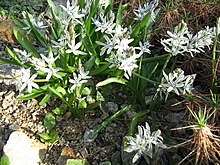| Fessia | |
|---|---|

| |
| Fessia puschkinioides in cultivation at the Berne Botanical Gardens | |
|
Scientific classification
| |
| Kingdom: | Plantae |
| Clade: | Tracheophytes |
| Clade: | Angiosperms |
| Clade: | Monocots |
| Order: | Asparagales |
| Family: | Asparagaceae |
| Subfamily: | Scilloideae |
| Genus: |
Fessia Speta [1] |
Fessia is a genus of bulbous flowering plants in the family Asparagaceae, subfamily Scilloideae (also treated as the family Hyacinthaceae). [2] It is distributed from Iran to Central Asia and Pakistan. [1]
Description
Species of Fessia grow from bulbs, which are covered by a gray or black tunic, purple inside. Each bulb produces one or more flower stems ( scapes) bearing whitish to blue or violet flowers. The stamens have pale blue anthers. The black seeds are globe or drop shaped. [3]
A number of species of Fessia, often under their earlier names in the genus Scilla, are grown by gardeners specializing in ornamental bulbous plants; they are hardy but some need a dry period in summer. F. puschkinioides (syn. Scilla puchkinioides) is described as "an easy to grow hardy species". [4]
Systematics
The genus Fessia was created by Franz Speta in 1998. All the species were previously included in a more broadly defined genus Scilla. [5] The genus is placed in the tribe Hyacintheae (or the subfamily Hyacinthoideae by those who use the family Hyacinthaceae). [6]
Species
As of March 2013 [update], the World Checklist of Selected Plant Families recognized 11 species: [5]
- Fessia bisotunensis (Speta) Speta
- Fessia furseorum (Meikle) Speta
- Fessia gorganica (Speta) Speta
- Fessia greilhuberi (Speta) Speta
- Fessia hohenackeri (Fisch. & C.A.Mey.) Speta
- Fessia khorassanica (Meikle) Speta
- Fessia parwanica (Speta) Speta
- Fessia purpurea (Griff.) Speta
- Fessia puschkinioides (Regel) Speta
- Fessia raewskiana (Regel) Speta
- Fessia vvedenskyi (Pazij) Speta
References
- ^ a b "Fessia", World Checklist of Selected Plant Families, Royal Botanic Gardens, Kew, retrieved 2013-04-02
- ^ Stevens, P.F. (2001 onwards), " Asparagales: Scilloideae", Angiosperm Phylogeny Website, retrieved 2013-04-02
- ^ "Fessia Speta", eMonocot, archived from the original on 2013-04-19, retrieved 2013-04-02
- ^ Mathew, Brian (1987), The Smaller Bulbs, London: B.T. Batsford, ISBN 978-0-7134-4922-8, pp. 152–153, 156
- ^ a b Search for "Fessia", World Checklist of Selected Plant Families, Royal Botanic Gardens, Kew, retrieved 2013-04-02
- ^ Pfosser, Martin; Speta, Franz (1999). "Phylogenetics of Hyacinthaceae based on plastid DNA sequences" (PDF). Annals of the Missouri Botanical Garden. 86 (4): 852–875. doi: 10.2307/2666172. JSTOR 2666172.